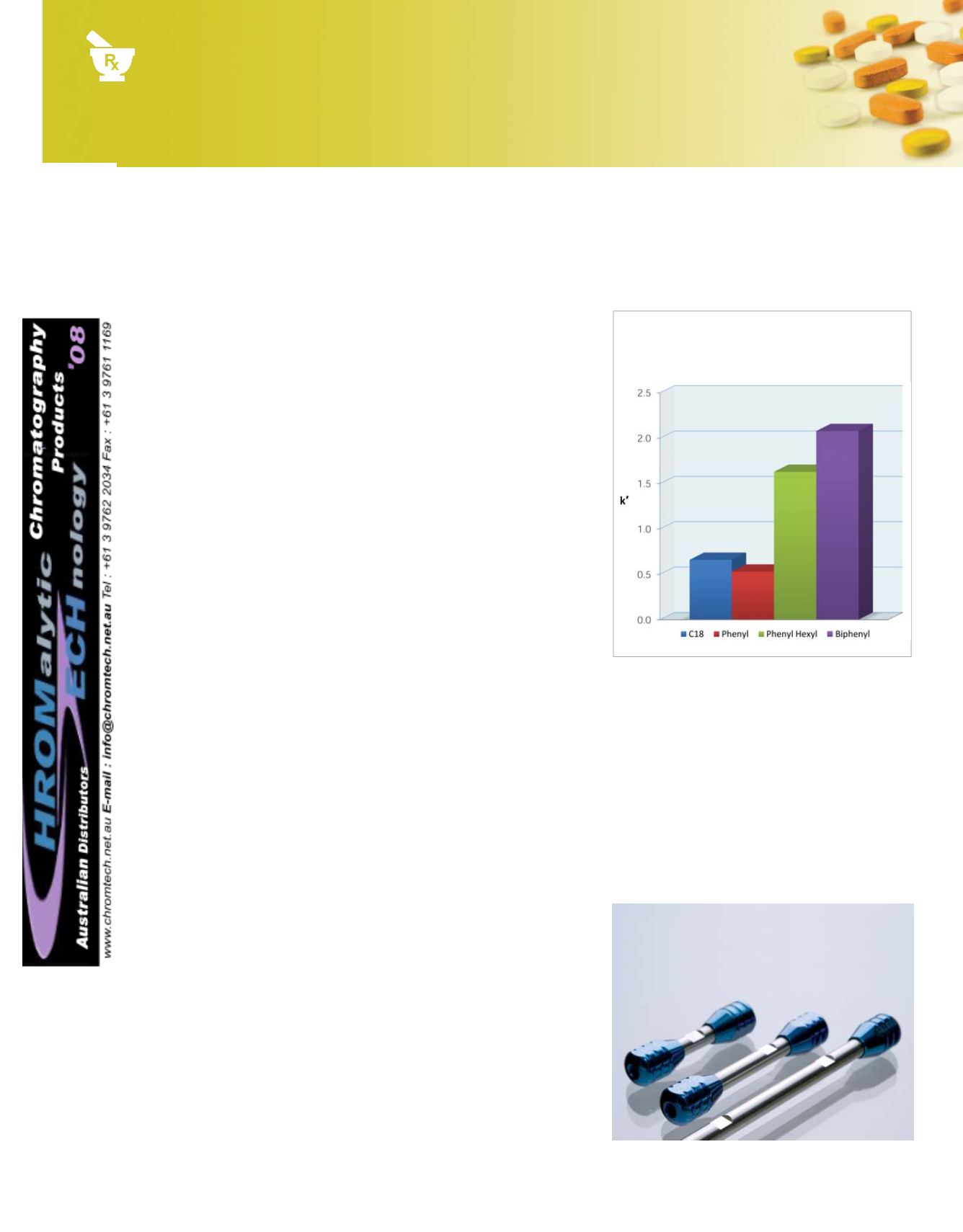

• 18 •
2008 vol. 3
Many drug classes include compounds with aromatic ring structures, some of
which also contain a sulfone or sulfoxide group. Both sulfur groups have
dipole moments, adding a hydrophilic character to compounds containing
these functional groups. The analysis of hydrophilic compounds on a tradi-
tional alkyl column (e.g., C18) can be problematic, since alkyl columns
depend on hydrophobic (dispersive) interactions for retention. Since the sul-
fone and sulfoxide groups contain
π
bonds, the Biphenyl column’s affinity
toward compounds containing these bonds makes it a logical choice when
increased retention of compounds containing these groups is desired.
To explore the selectivity of the biphenyl phase towards sulfur-containing aro-
matic compounds, phenyl sulfone, a simple probe, was analyzed on alkyl
(C18), phenyl, phenyl hexyl, and Biphenyl columns to determine the relative
retention of each phase, as measured by capacity factor (k'). In order to ensure
separation of analytes from unretained contaminants, a minimum k' value of
2 is recommended for most analyses, however in cases where there is little to
no matrix interference, a k' of 1 may be acceptable. The data in Figure 1 show
that phenyl sulfone is retained to a much greater degree on the Pinnacle® DB
Biphenyl column, than on the other phases tested (k' = 2.08). This is due to
the unique retention mechanism of the biphenyl stationary phase, which can
interact with both the hydrophobic aromatic ring and the hydrophilic sulfone
group through
π
-
π
interactions. Although the phenyl stationary phase also
allows for the use of
π
-
π
interactions, the biphenyl phase has a larger electron
cloud and is significantly more retentive.
To further test the retention of the Biphenyl column, a second set of probes,
consisting of compounds in the NSAID family, was analyzed. Tenoxicam,
which contains a sulfone group, and sulfinpyrazone, which contains a sulfox-
ide group, were analyzed along with a void marker (uracil). Although these
compounds are more complex than the probe used in the first experiment, the
same pattern of retention was observed (Figure 2). The Pinnacle® DB
Biphenyl column exhibited the greatest retention for tenoxicam. With k' values
of 0.33 on the C18 and 0.49 on the phenyl columns, tenoxicam shows almost
no retention on these stationary phases. The phenyl hexyl phase performed
slightly better with a k' value of 1.52 for tenoxicam. However, when tenoxicam
was analyzed on the Biphenyl column under the same conditions, the k' value
increased to 2.22, a value much more likely to provide adequate resolution
from matrix components. Sulfinpyrazone, a less polar compound, also fol-
lowed the same pattern of retention (Table I).
The improved retention for hydrophilic aromatics shown here is due to the
unique
π
-
π
interaction retention mechanism of the Biphenyl phase. This
mechanism is particularly useful for analysis of sulfone- and sulfoxide-con-
taining drug compounds, which are not easily retained on alkyl or phenyl
phases. The Biphenyl phase provides greater retention than alkyl and phenyl
phases and is ideal for separating difficult-to-retain polar aromatics from
unretained matrix contaminants.
Figure 1
The Biphenyl phase is more
retentive for phenyl sulfone than other
alkyl and phenyl phases.
Beyond C18—Increase Retention of Hydrophilic
Compounds Using Biphenyl Columns
Searching for a better way to retain hydrophilic aromatic drug compounds? Biphenyl phases, such
as the
Pinnacle® DB Biphenyl
column, provide greater retention than alkyl phases. Use a
Biphenyl column to separate difficult-to-retain polar aromatics fromunretainedmatrix contaminants.
By Amanda Rigdon, Pharmaceutical Innovations Chemist and Rick Lake, Pharmaceutical Market Development Manager
Biphenyl columns are
much more effective
than alkyl, phenyl, or
phenyl hexyl phases
when increased retention
of hydrophilic aromatics
is desired.
Pharmaceutical
Pinnacle® DB 1.9μm
columns available!
www.restek.com/uhplc800-356-1688 •
www.restek.com










